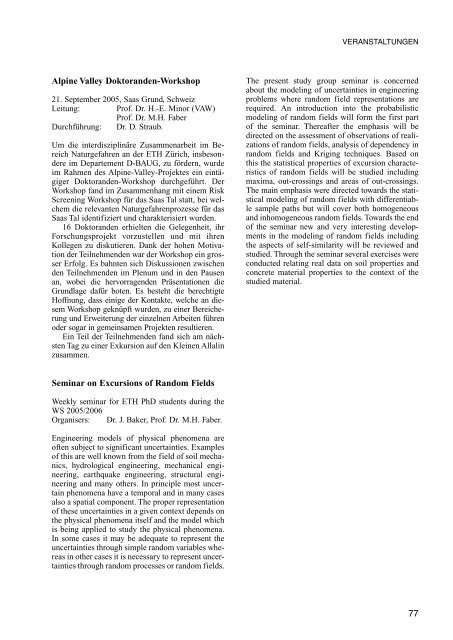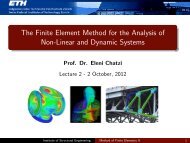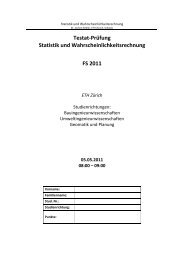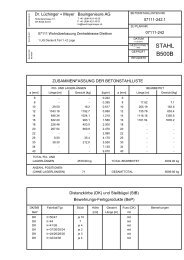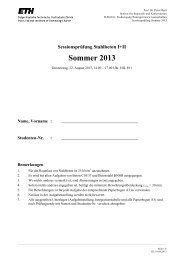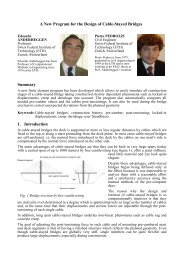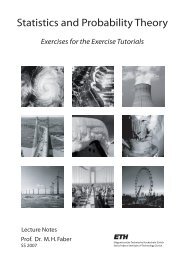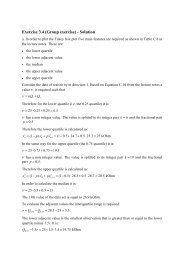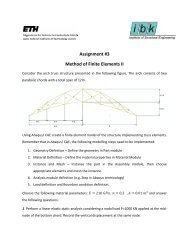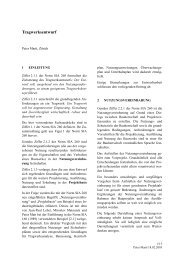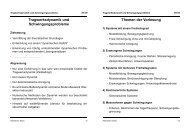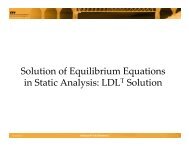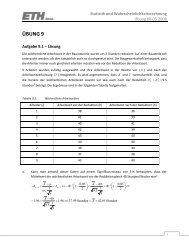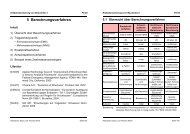IBK Jahresbericht 2004-2006 - Institut für Baustatik und Konstruktion ...
IBK Jahresbericht 2004-2006 - Institut für Baustatik und Konstruktion ...
IBK Jahresbericht 2004-2006 - Institut für Baustatik und Konstruktion ...
Erfolgreiche ePaper selbst erstellen
Machen Sie aus Ihren PDF Publikationen ein blätterbares Flipbook mit unserer einzigartigen Google optimierten e-Paper Software.
VERANSTALTUNGEN<br />
Alpine Valley Doktoranden-Workshop<br />
21. September 2005, Saas Gr<strong>und</strong>, Schweiz<br />
Leitung: Prof. Dr. H.-E. Minor (VAW)<br />
Prof. Dr. M.H. Faber<br />
Durchführung: Dr. D. Straub.<br />
Um die interdisziplinäre Zusammenarbeit im Bereich<br />
Naturgefahren an der ETH Zürich, insbesondere<br />
im Departement D-BAUG, zu fördern, wurde<br />
im Rahmen des Alpine-Valley-Projektes ein eintägiger<br />
Doktoranden-Workshop durchgeführt. Der<br />
Workshop fand im Zusammenhang mit einem Risk<br />
Screening Workshop <strong>für</strong> das Saas Tal statt, bei welchem<br />
die relevanten Naturgefahrenprozesse <strong>für</strong> das<br />
Saas Tal identifiziert <strong>und</strong> charakterisiert wurden.<br />
16 Doktoranden erhielten die Gelegenheit, ihr<br />
Forschungsprojekt vorzustellen <strong>und</strong> mit ihren<br />
Kollegen zu diskutieren. Dank der hohen Motivation<br />
der Teilnehmenden war der Workshop ein grosser<br />
Erfolg. Es bahnten sich Diskussionen zwischen<br />
den Teilnehmenden im Plenum <strong>und</strong> in den Pausen<br />
an, wobei die hervorragenden Präsentationen die<br />
Gr<strong>und</strong>lage da<strong>für</strong> boten. Es besteht die berechtigte<br />
Hoffnung, dass einige der Kontakte, welche an diesem<br />
Workshop geknüpft wurden, zu einer Bereicherung<br />
<strong>und</strong> Erweiterung der einzelnen Arbeiten führen<br />
oder sogar in gemeinsamen Projekten resultieren.<br />
Ein Teil der Teilnehmenden fand sich am nächsten<br />
Tag zu einer Exkursion auf den Kleinen Allalin<br />
zusammen.<br />
The present study group seminar is concerned<br />
about the modeling of uncertainties in engineering<br />
problems where random field representations are<br />
required. An introduction into the probabilistic<br />
modeling of random fields will form the first part<br />
of the seminar. Thereafter the emphasis will be<br />
directed on the assessment of observations of realizations<br />
of random fields, analysis of dependency in<br />
random fields and Kriging techniques. Based on<br />
this the statistical properties of excursion characteristics<br />
of random fields will be studied including<br />
maxima, out-crossings and areas of out-crossings.<br />
The main emphasis were directed towards the statistical<br />
modeling of random fields with differentiable<br />
sample paths but will cover both homogeneous<br />
and inhomogeneous random fields. Towards the end<br />
of the seminar new and very interesting developments<br />
in the modeling of random fields including<br />
the aspects of self-similarity will be reviewed and<br />
studied. Through the seminar several exercises were<br />
conducted relating real data on soil properties and<br />
concrete material properties to the context of the<br />
studied material.<br />
Seminar on Excursions of Random Fields<br />
Weekly seminar for ETH PhD students during the<br />
WS 2005/<strong>2006</strong><br />
Organisers: Dr. J. Baker, Prof. Dr. M.H. Faber.<br />
Engineering models of physical phenomena are<br />
often subject to significant uncertainties. Examples<br />
of this are well known from the field of soil mechanics,<br />
hydrological engineering, mechanical engineering,<br />
earthquake engineering, structural engineering<br />
and many others. In principle most uncertain<br />
phenomena have a temporal and in many cases<br />
also a spatial component. The proper representation<br />
of these uncertainties in a given context depends on<br />
the physical phenomena itself and the model which<br />
is being applied to study the physical phenomena.<br />
In some cases it may be adequate to represent the<br />
uncertainties through simple random variables whereas<br />
in other cases it is necessary to represent uncertainties<br />
through random processes or random fields.<br />
77


